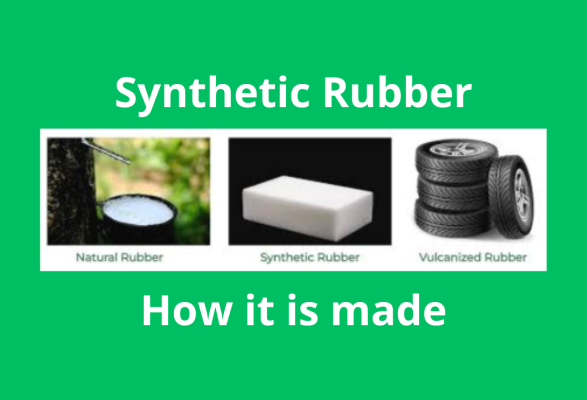Synthetic rubber was invented in 1909 but the technology languished for a couple of decades a shortage of natural rubber during world war II spurred its development a kind of elastic plastic, it was actually more resistant to temperature extremes than natural rubber. Synthetic rubber reinvented the wheel we’re talking about the rubber tire for all kinds of vehicles are now made from it. This man-made material is also used to make everything from garden horses to golf balls. Manufacturing synthetic rubber is now a computerized process that takes place under the watchful eye of a control room operator. He monitors numerous computer screens and live camera images the plan itself is 437 yards long. There are a dozen or more enormous storage tanks for the raw materials as well as several reactor units the raw materials include a petroleum – based liquid called butadiene and solvent called hexane they pipe these ingredients through columns to boil off any residual water essentially purifying them this is a laboratory demonstration of what happens. Next they combined the purified butadiene and hexane and add a catalyst. The catalyst triggers a reaction that changes the chemistry and the mix becomes polybutadiene – a kind of synthetics used to make tires adding another catalyst stops the reaction at just the right moment. The white milky liquid that exits the tank is synthetic rubber. They now pump in chemicals to tailor the rubber for a specific use in this case. The additives will increase traction and improve wear; a mechanized whisk stirs the additives into the liquid rubber. The pipe the synthetic concoction into insulated storage tanks inside pumps mix it constantly so the additives don’t settle on the bottom. Here’s a close-up look at the liquid synthetic rubber in a laboratory beaker. It look like a big vanilla milkshake and it’s about to be coagulated into crumbs. Here is where it all happens. This coagulation is like a big kettle they pipe in the liquid rubber a solvent mixture and water as they boil off the solvent the rubber coagulates into crumbs the size of beans the water remains because it has higher boiling point. The mix of water and rubber crumbs bounces about in what’s known. As the crumb tank until it’s time for more processing. They then pump the mix into a rotary sieve as it spins it drains off the water. They add more water to cool the rubber crumbs. The rubber and water gushes into a conveyor which is a vibrating sieve as the crumbs bounce along the water drains off through the perforations in the conveyor. The synthetic rubber is now a lot like wet snow. Next it’s into the lab where they aim a beam of infrarred light through a sample to analyze the microstructure. If it’s acceptable, production continues. A screw-like mechanism presses the wet rubber crumbs against a metal plate to squeeze out more moisture. Another trip on the next vibrating conveyor drains off droplets then it’s into a quivering spiral conveyor. As the synthetic rubber travels upwards on the spiral hot air is piped in from the side to dry it. Now mostly devoid of moisture but still sticky the synthetic rubber crumbs head down a chute and into a baler machine. This machine uses pressure to compress the crumbs into big bales. The bales of synthetic rubber head down a conveyor towards a quality control inspector. This inspector examines them for imperfections. Once he gives them ok, they head to the packaging station. As they travel through a curtain of plastic film machinery heat seals it around them. These bales of synthetic rubber have taken about six hours to manufacture and this purely chemical creation is not much different from the real thing like natural rubber it can be melted and shaped into many different things. Soon this batch will be turned into tires and that’s when the synthetic rubber will really hit the road.





